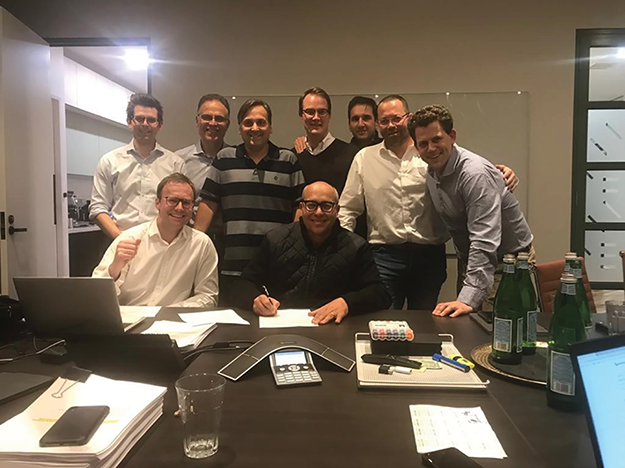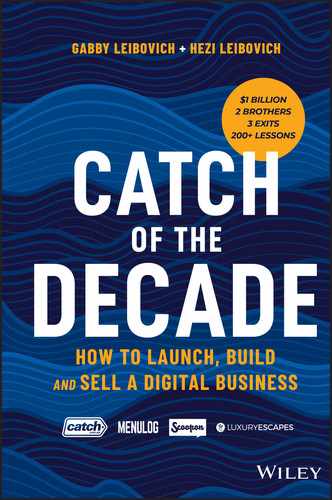CHAPTER 17
Wesfarmers come calling
Wesfarmers is one of Australia's largest listed companies. It started as a farmers' cooperative back in 1914 and now is a diversified conglomerate worth over $50 billion, with retail operations that include blue‐chip operations such as Bunnings, Kmart, Target and Officeworks. You could say they know retail.
So, imagine our surprise when we strolled into work one morning to find an email from the heads of Wesfarmers sitting in our inbox. The subject line? ‘Catch up?’ There were other lines in that email that caught our eye. ‘Comparing notes on ways we can work together’ and ‘A marketplace offer is an obvious hole in our strategy’.
Our first reaction?
Holy shit! Is this what we think it is? Is Wesfarmers, this monolith of Australia's greatest brands, courting us? It is and they were. Could our Fair-Etail get any better?
Here's what happened.

Signing the Wesfarmers deal. Choose your advisers carefully. Standing, from left to right: Jason Bagg, Steven KIein, Hezi, Ronan Fenton, Nati, Guy Biran, Quentin Miller. Seated: Joshua Heard, Gabby.
The Midas touch
The due diligence process that took place was … diligent … as you would expect from a company this size, but what worked in our favour was that because we had done the groundwork for the IPO a few months earlier, our financials, prospectus and roadmap were already in order. That marathon roadshow of meetings we attended a year earlier prepped us perfectly for the barrage of discussions that would take place before this deal could be consummated.
The speed at which we delivered this due diligence demonstrated to Wesfarmers we were a company that had its act together. What else played in our favour was that we were a tremendously profitable company, we were growing at a rate of knots, and we were led by a super‐motivated management team that was doing it better than almost any company in the sector.
Throughout the due diligence process, we made a point of not being present at the meetings or being part of the strategic conversations. We wanted to send a deliberate message to Wesfarmers (and our own team) that the founding brothers would not be continuing with the business and that it would be led by the CEO and the wider management team. Our rationale was, and has always been, that we hired smart people because they were smart, and that this was the moment to let them do what we had hired them to do: lead the company.
We, as the founders of the company, knew from the get‐go that Wesfarmers would only be interested in buying 100 per cent of the business. The truth was, we would have loved to have kept a small slice of the business and continued supporting it in any way possible, but we just knew that this would not be acceptable to Wesfarmers.
People often ask why Wesfarmers took such an interest in our business. We've asked ourselves the same question, and after many discussions with them, the reasons became clear. They were impressed with our digital expertise, logistics capability, sustained profitability, the Catch marketplace and its ability to provide customers of Wesfarmers’ retail businesses with an alternative to Amazon.
These were the tangibles that made us attractive, but there were some intangibles that made us equally appealing. When Ian Bailey, the Managing Director of Kmart and Target, addressed our warehouse team soon after the transaction, he put into words what many in the industry had grappled with—namely, why we had been successful when so many had not. He said:
We have been observing Catch for a number of years now, and it feels like year after year you are advancing forward and building a stronger and stronger business. This is not an easy thing to do in such a competitive market and it is a great testament to the hard work, focus and innovation of the leadership and the team in Catch.
The other intangible reason that made us attractive as an acquisition was our extraordinary team and the intrapreneurial energy they brought to the business. They represented the culture that had made Catch so successful.
This acquisition deal was nine months in the making and involved hundreds of people at various levels of both corporations working closely to bring it to fruition. But interestingly, not one person from either team leaked the news to the media or the industry. We were able to conduct these protracted and complex negotiations in secret, which made it much easier for everyone involved to do the work that needed to be done. We think it's a testament to the teams on both sides that their loyalty trumped their temptation to leak what would be a very tasty morsel of industry gossip.
As we wander through the many Wesfarmers‐owned companies that dominate the shopping malls of retail Australia we are heartened to see that they have implemented many of the marketing strategies that were innovated and incubated at Catch. One of our proudest moments was walking into Melbourne's Highpoint Shopping Centre at Maribyrnong and seeing a Catch store‐within‐a‐store right there inside Target. Our little online store that started in a garage was up in lights inside a shopping icon. Surreal. It's the only word that can truly describe how that feels.
